Lignin Microspheres Modified with Magnetite Nanoparticles as a Selenate Highly Porous Adsorbent
Abstract
:1. Introduction
2. Results and Discussion
2.1. Material Synthesis and Design
2.2. The Effect of Adsorbent Dose
2.3. The Effect of Selenium Concentration
2.4. Kinetic Studies
2.5. Properties of Loaded Adsorbent
2.5.1. FTIR Analysis
2.5.2. XRD Analysis
2.5.3. SEM/EDS Analysis
2.6. Desorption Test—Regeneration Capacity
2.7. Real Water Samples
3. Discussion
| Adsorbent Type | Preparation/ Modification Method | pH | T (°C) | Concentration Se (mg L−1) | Adsorption Models | Kinetic Models | Adsorption Capacity (mg g−1) | Ref. |
|---|---|---|---|---|---|---|---|---|
| Fe3O4 | Commercial | 7 | 25 | 5 | - | PFO | 2.19 | [36] |
| 7 | 25 | 5 | - | PSO | 0.21 | |||
| MIO-MWCNTs: magnetic iron oxide nanoparticle/multi-walled carbon nanotubes | 1.8–7.1 | 15 | 5–100 | - | PFO | 3.799 | [37] | |
| 30 | 3.757 | |||||||
| 45 | 3.640 | |||||||
| 1.8–7.1 | 15 | 5–100 | - | PSO | 3.928 | |||
| 30 | 3.843 | |||||||
| 45 | 3.779 | |||||||
| Metal organic framework (MOF) | ||||||||
| Mercapto functionalized Zr-based magnetic metal–organic framework MUS: Fe3O4@SiO2@UiO-66-(SH)2(MUS) | Coprecipitation andsol–gel method | 2 | - | 10–360 | Langmuir | PSO | 27.3 | [38] |
| Binary MOFs, UiO-66(Fe/Zr) | Hydrothermal method | 5 | - | 10–50 | Langmuir | PSO | 258 | [39] |
| Poly(allyl trimethylammonium) grafted chitosan and biochar-BC composite (PATMAC-CTS-BC) | Polymerization process | 5 | 25 | 10–50 | Langmuir | 98.99 | [40] | |
| PFO | 36.97 | |||||||
| PSO | 37.39 | |||||||
| Exfoliated kaolinite sheets/cellulose fibers nanocomposite (EXK/CF) | - | 2 | - | 50 | Langmuir | 137.5 | [43] | |
| PFO | 74.5 | |||||||
| PSO | 88.5 | |||||||
| Iron-impregnated food waste biochar (Fe-FWB) | - | 7 | 25 | 100–300 | Langmuir | 11.7 | [42] | |
| Magnetic biochar with magnetite nanoparticles MBC-SPS-450 | - | 5 | 23 ± 1 | 183 | Freundlich | −98.03 | [41] | |
| 7 | 384.62 | |||||||
| 9 | 333.33 | |||||||
| Lignin microspheres modified with magnetite nanoparticles: A-LMS Fe3O4 | Coprecipitation and copolymerization process | 6.45 | 22 | 7.75 | Adsorption isotherm | 69.9 | ||
| PFO | 29.64 | This study | ||||||
| PSO | 41.56 |
4. Materials and Methods
4.1. Material Synthesis and Design
4.2. Analytical Reagents and Determination of Concentration
4.3. Adsorption Experiment and Kinetic Study
4.4. Material Characterization
4.5. Desorption Test
4.6. Adsorbent Application in Real Water (Potable) Samples
5. Conclusions
- The removal efficiency of Se(VI) anions from the synthetic water samples was ≈99%, while for the real water samples, it was around 20%, indicating a competitive influence/effect of other ions present in water.
- The pseudo-second model was the most appropriate for the kinetic data description; adsorption capacity of investigated adsorbent towards Se(VI) was found to be 34.94 mg/g.
- The regeneration capacity of 61% in 0.5 M NaOH, as a desorption solution, was obtained in the first cycle.
- Despite that the desorption efficiency was relatively low, precisely such Se loaded sorbent could be used as a soil fertilizer, considering that minimal pre/post chemical treatment of this material is necessary.
Supplementary Materials
Author Contributions
Funding
Institutional Review Board Statement
Informed Consent Statement
Data Availability Statement
Conflicts of Interest
References
- Noreen, S.; Mustafa, G.; Ibrahim, S.M.; Naz, S.; Iqbal, M.; Yaseen, M.; Javed, T.; Nisar, J. Iron oxide (Fe2O3) prepared via green route and adsorption efficiency evaluation for an anionic dye: Kinetics, isotherms and thermodynamics studies. J. Mater. Res. Technol. 2020, 9, 4206–4217. [Google Scholar] [CrossRef]
- Khamkhash, A.; Srivastava, V.; Ghosh, T.; Akdogan, G.; Ganguli, R.; Aggarwal, S. Mining-related selenium contamination in Alaska, and the state of current knowledge. Minerals 2017, 7, 46. [Google Scholar] [CrossRef]
- Benis, K.Z.; McPhedran, K.N.; Soltan, J. Selenium removal from water using adsorbents: A critical review. J. Hazard. Mater. 2022, 424, 127603. [Google Scholar] [CrossRef] [PubMed]
- Börsig, N.; Scheinost, A.C.; Schild, D.; Neumann, T. Mechanisms of selenium removal by partially oxidized magnetite nanoparticles for wastewater remediation. Appl. Geochem. 2021, 132, 105062. [Google Scholar] [CrossRef]
- Kieliszek, M.; Błazejak, S. Selenium: Significance, and outlook for supplementation. Nutrition 2013, 29, 713–718. [Google Scholar] [CrossRef]
- Kieliszek, M.; Błazejak, S. Current knowledge on the importance of selenium in food for living organisms: A review. Molecules 2016, 21, 609. [Google Scholar] [CrossRef] [Green Version]
- Herschy, R.W. Water quality for drinking: WHO guidelines. Encycl. Earth Sci. Ser. 2012, 8, 876–883. [Google Scholar] [CrossRef]
- He, Y.; Xiang, Y.; Zhou, Y.; Yang, Y.; Zhang, J.; Huang, H.; Shang, C.; Luo, L.; Gao, J.; Tang, L. Selenium contamination, consequences and remediation techniques in water and soils: A review. Environ. Res. 2018, 164, 288–301. [Google Scholar] [CrossRef]
- Dotan, A. 15-Biobased Thermosets. In Handbook of Thermoset Plastics, 3rd ed.; Dodiuk, H., Goodman, S.H., Eds.; Elsevier Inc.: Chadds Ford, PA, USA, 2014; pp. 577–622. [Google Scholar]
- Popovic, A. Sinteza, Karakterizacija i Primena Modifikovanih Mikrosfera na bazi Lignina za Uklanjanje Jona Teških Metala, Oksianjona i Diklofenaka iz Vode; TMF: Beograd, Serbia, 2020. [Google Scholar]
- Scimmi, C.; Sancineto, L.; Drabowicz, J.; Santi, C. New Insights into Green Protocols for Oxidative Depolymerization of Lignin and Lignin Model Compounds. Int. J. Mol. Sci. 2022, 23, 4378. [Google Scholar] [CrossRef]
- El-Shafey, E.I. Removal of Se(IV) from aqueous solution using sulphuric acid-treated peanut shell. J. Environ. Manag. 2007, 84, 620–627. [Google Scholar] [CrossRef]
- El-Shafey, E.I. Sorption of Cd(II) and Se(IV) from aqueous solution using modified rice husk. J. Hazard. Mater. 2007, 147, 546–555. [Google Scholar] [CrossRef] [PubMed]
- Gan, X.; Huang, J.C.; Zhou, C.; He, S.; Zhou, W. Relationship between selenium removal efficiency and production of lipid and hydrogen by Chlorella vulgaris. Chemosphere 2019, 217, 825–832. [Google Scholar] [CrossRef] [PubMed]
- Wang, Y.; Wang, Z.J.; Huang, J.C.; Zhou, C.; Zou, H.; He, S.; Chen, V.Y.C. Feasibility of using Chlorella vulgaris for the removal of selenium and chromium in water: Competitive interactions with sulfur, physiological effects on algal cells and its resilience after treatment. J. Clean. Prod. 2021, 313, 127939. [Google Scholar] [CrossRef]
- Khakpour, H.; Younesi, H.; Mohammadhosseini, M. Two-stage biosorption of selenium from aqueous solution using dried biomass of the baker’s yeast Saccharomyces cerevisiae. J. Environ. Chem. Eng. 2014, 2, 532–542. [Google Scholar] [CrossRef]
- Kongsri, S.; Janpradit, K.; Buapa, K.; Techawongstien, S.; Chanthai, S. Nanocrystalline hydroxyapatite from fish scale waste: Preparation, characterization and application for selenium adsorption in aqueous solution. Chem. Eng. J. 2013, 215–216, 522–532. [Google Scholar] [CrossRef]
- Nettem, K.; Almusallam, A.S. Equilibrium, Kinetic, and Thermodynamic Studies on the Biosorption of Selenium (IV) Ions onto Ganoderma Lucidum Biomass. Sep. Sci. Technol. 2013, 48, 2293–2301. [Google Scholar] [CrossRef]
- Sabuda, M.C.; Rosenfeld, C.E.; DeJournett, T.D.; Schroeder, K.; Wuolo-Journey, K.; Santelli, C.M. Fungal Bioremediation of Selenium-Contaminated Industrial and Municipal Wastewaters. Front. Microbiol. 2020, 11, 2105. [Google Scholar] [CrossRef]
- González-Acevedo, Z.I.; Olguín, M.T.; Rodríguez-Martínez, C.E.; Frías-Palos, H. Sorption and desorption processes of selenium (VI) using non-living biomasses of aquatic weeds in horizontal flow. Water. Air. Soil Pollut. 2012, 223, 4119–4128. [Google Scholar] [CrossRef]
- Karić, N.; Maia, A.S.; Teodorović, A.; Atanasova, N.; Langergraber, G.; Crini, G.; Ribeiro, A.R.L.; Đolić, M. Bio-waste valorisation: Agricultural wastes as biosorbents for removal of (in)organic pollutants in wastewater treatment. Chem. Eng. J. Adv. 2022, 9, 100239. [Google Scholar] [CrossRef]
- Gonzalez, C.M.; Hernandez, J.; Peralta-Videa, J.R.; Botez, C.E.; Parsons, J.G.; Gardea-Torresdey, J.L. Sorption kinetic study of selenite and selenate onto a high and low pressure aged iron oxide nanomaterial. J. Hazard. Mater. 2012, 211–212, 138–145. [Google Scholar] [CrossRef]
- Wei, R.C.; Bhojappa, X.; Lin, S.; Viadero, L.S. Performance of nano-magnetite for removal of selenium from aqueous solutions. Environ. Eng. Sci. 2012, 29, 526–632. [Google Scholar] [CrossRef]
- Popovic, A.L.; Rusmirovic, J.D.; Velickovic, Z.; Radovanovic, Z.; Ristic, M.; Pavlovic, V.P.; Marinkovic, A.D. Novel amino-functionalized lignin microspheres: High performance biosorbent with enhanced capacity for heavy metal ion removal. Int. J. Biol. Macromol. 2020, 156, 1160–1173. [Google Scholar] [CrossRef] [PubMed]
- Services, H. Health Effects. Toxicol. Ind. Health 1999, 15, 655–701. [Google Scholar] [CrossRef]
- Popovic, A.L.; Velickovic, Z.; Radovanovic, Z.; Djolic, M.; Pavlovic, V.; Marinkovic, A.D.; Grzetic, J.D. Hybrid amino-terminated lignin microspheres loaded with magnetite and manganese oxide nanoparticles: An effective hazardous oxyanions adsorbent. J. Environ. Chem. Eng. 2022, 10, 108009. [Google Scholar] [CrossRef]
- Lin, H.; Qiu, S.; Wu, Z.; Ye, X.; Liu, M. Fabrication of lignin-based biochar containing multi-metal ferrite and efficient removal for oxytetracycline hydrochloride. J. Clean. Prod. 2022, 331, 129885. [Google Scholar] [CrossRef]
- Available online: https://www.sigmaaldrich.com/RS/en/technical-documents/technical-article/analytical-chemistry/photometry-and-reflectometry/ir-spectrum-table (accessed on 20 October 2022).
- Nandiyanto, A.B.D.; Oktiani, R.; Ragadhita, R. How to read and interpret ftir spectroscope of organic material. Indones. J. Sci. Technol. 2019, 4, 97–118. [Google Scholar] [CrossRef] [Green Version]
- Ge, Y.; Qin, L.; Li, Z. Lignin microspheres: An effective and recyclable natural polymer-based adsorbent for lead ion removal. Mater. Des. 2016, 95, 141–147. [Google Scholar] [CrossRef]
- Gosselink, A.R.J. Lignin as a Renewable Aromatic Resource for the Chemical Industry. Ph.D. Thesis, Wageningen University, Wageningen, The Netherlands, 2011; pp. 1–196. Available online: https://edepot.wur.nl/186285 (accessed on 18 October 2022).
- Nalbandian, L.; Patrikiadou, E.; Zaspalis, V.; Patrikidou, A.; Hatzidaki, E.; Papandreou, C.N. Magnetic Nanoparticles in Medical Diagnostic Applications: Synthesis, Characterization and Proteins Conjugation. Curr. Nanosci. 2016, 12, 455–468. Available online: https://www.ingentaconnect.com/content/ben/cnano/2016/00000012/00000004/art00010 (accessed on 21 October 2022). [CrossRef]
- Goudarzi, A.; Lin, L.T.; Ko, F.K. X-ray diffraction analysis of kraft lignins and lignin-derived carbon nanofibers. J. Nanotechnol. Eng. Med. 2014, 5, 021006. [Google Scholar] [CrossRef]
- Trivedi, M.K.; Sethi, K.K.; Panda, P.; Jana, S. Sodyum selenat’ın XRD, PSD, DSC, TGA/DTG, UV-VIS ve FT-IR yöntemleri ile fizikokimyasal, termal ve spektroskopik karakterizasyonu. Marmara Pharm. J. 2017, 21, 311–318. [Google Scholar] [CrossRef]
- Alfthan, G.; Eurola, M.; Ekholm, P.; Venäläinen, E.R.; Root, T.; Korkalainen, K.; Hartikainen, H.; Salminen, P.; Hietaniemi, V.; Aspila, P.; et al. Effects of nationwide addition of selenium to fertilizers on foods, and animal and human health in Finland: From deficiency to optimal selenium status of the population. J. Trace Elem. Med. Biol. 2015, 31, 142–147. [Google Scholar] [CrossRef] [PubMed]
- Okonji, S.O.; Dominic, J.A.; Pernitsky, D.; Achari, G. Removal and recovery of selenium species from wastewater: Adsorption kinetics and co-precipitation mechanisms. J. Water Process Eng. 2020, 38, 101666. [Google Scholar] [CrossRef]
- Lee, C.G.; Kim, S.B. Removal of arsenic and selenium from aqueous solutions using magnetic iron oxide nanoparticle/multi-walled carbon nanotube adsorbents. Desalin. Water Treat. 2016, 57, 28323–28339. [Google Scholar] [CrossRef]
- Sun, N.; He, M.; Chen, B.; Hu, B. Mercapto-functionalized magnetic metal–organic framework for simultaneous removal of inorganic selenium and antimony species. Sep. Purif. Technol. 2022, 301, 121952. [Google Scholar] [CrossRef]
- Guo, Q.; Ma, X.P.; Zheng, L.W.; Zhao, C.X.; Wei, X.Y.; Xu, Y.; Li, Y.; Xie, J.J.; Zhang, K.G.; Yuan, C.G. Exceptional removal and immobilization of selenium species by bimetal-organic frameworks. Ecotoxicol. Environ. Saf. 2022, 245, 114097. [Google Scholar] [CrossRef]
- Zhang, L.; Jiang, S.C.; Guan, Y. Efficient removal of selenate in water by cationic poly(allyltrimethylammonium) grafted chitosan and biochar composite. Environ. Res. 2021, 194, 110667. [Google Scholar] [CrossRef]
- Manoko, M.C.; Chirwa, E.M.M.; Makgopa, K. Non-demineralized paper waste sludge derived magnetic biochar as sorbs for removal of methylene blue, phosphorus, and selenate in wastewater. Clean. Chem. Eng. 2022, 3, 100048. [Google Scholar] [CrossRef]
- Hong, S.H.; Lyonga, F.N.; Kang, J.K.; Seo, E.J.; Lee, C.G.; Jeong, S.; Hong, S.G.; Park, S.J. Synthesis of Fe-impregnated biochar from food waste for Selenium(Ⅵ) removal from aqueous solution through adsorption: Process optimization and assessment. Chemosphere 2020, 252, 126475. [Google Scholar] [CrossRef]
- Abukhadra, M.R.; AlHammadi, A.; El-Sherbeeny, A.M.; Salam, M.A.; El-Meligy, M.A.; Awwad, E.M.; Luqman, M. Enhancing the removal of organic and inorganic selenium ions using an exfoliated kaolinite/cellulose fibres nanocomposite. Carbohydr. Polym. 2021, 252, 117163. [Google Scholar] [CrossRef]
- Popović, A.; Rusmirović, J.; Đolić, M.; Veličković, Z.; Marinković, A. Lignin Based Porous, Microsphere-Shaped Adsorbent Functionalized with Magnetite Nanoparticles for Effective Chromate Anions Removal. Zbornik Međunarodnog Kongr. Procesnoj Ind.–Process. 2021, 34, 133–139. [Google Scholar] [CrossRef]
- Lagergren, S. Zur theorieder sogennanten adsorption geloester stoffe. Bih. Till K. Sven. Vetensk. Handl. 1898, 24, 1–39. [Google Scholar]
- Revellame, E.D.; Fortela, D.L.; Sharp, W.; Hernandez, R.; Zappi, M.E. Adsorption kinetic modeling using pseudo-first order and pseudo-second order rate laws: A review. Clean. Eng. Technol. 2020, 1, 100032. [Google Scholar] [CrossRef]
- Ho, Y.S.; McKay, G. Pseudo-second order model for sorption processes. Process Biochem. 1999, 34, 451–465. [Google Scholar] [CrossRef]
- Weber, W.J.; Morris, J.C. Kinetics of Adsorption on Carbon from Solution. J. Sanit. Eng. Div. 1963, 89, 31–60. Available online: https://cedb.asce.org/CEDBsearch/record.jsp?dockey=0013042 (accessed on 10 September 2022). [CrossRef]
- Wang, J.; Guo, X. Review on the Intraparticle Diffusion Adsorption Kinetics Model: Interpretation, Solving Methods and Applications. SSRN Electron. J. 2022, 309, 136732. [Google Scholar] [CrossRef]
- Selvaraj, R.; Murugesan, G.; Rangasamy, G.; Bhole, R.; Dave, N.; Pai, S.; Balakrishna, K.; Vinayagam, R.; Varadavenkatesan, T. As (III) removal using superparamagnetic magnetite nanoparticles synthesized using Ulva prolifera− optimization, isotherm, kinetic and equilibrium studies. Chemosphere 2022, 308, 136271. [Google Scholar] [CrossRef]
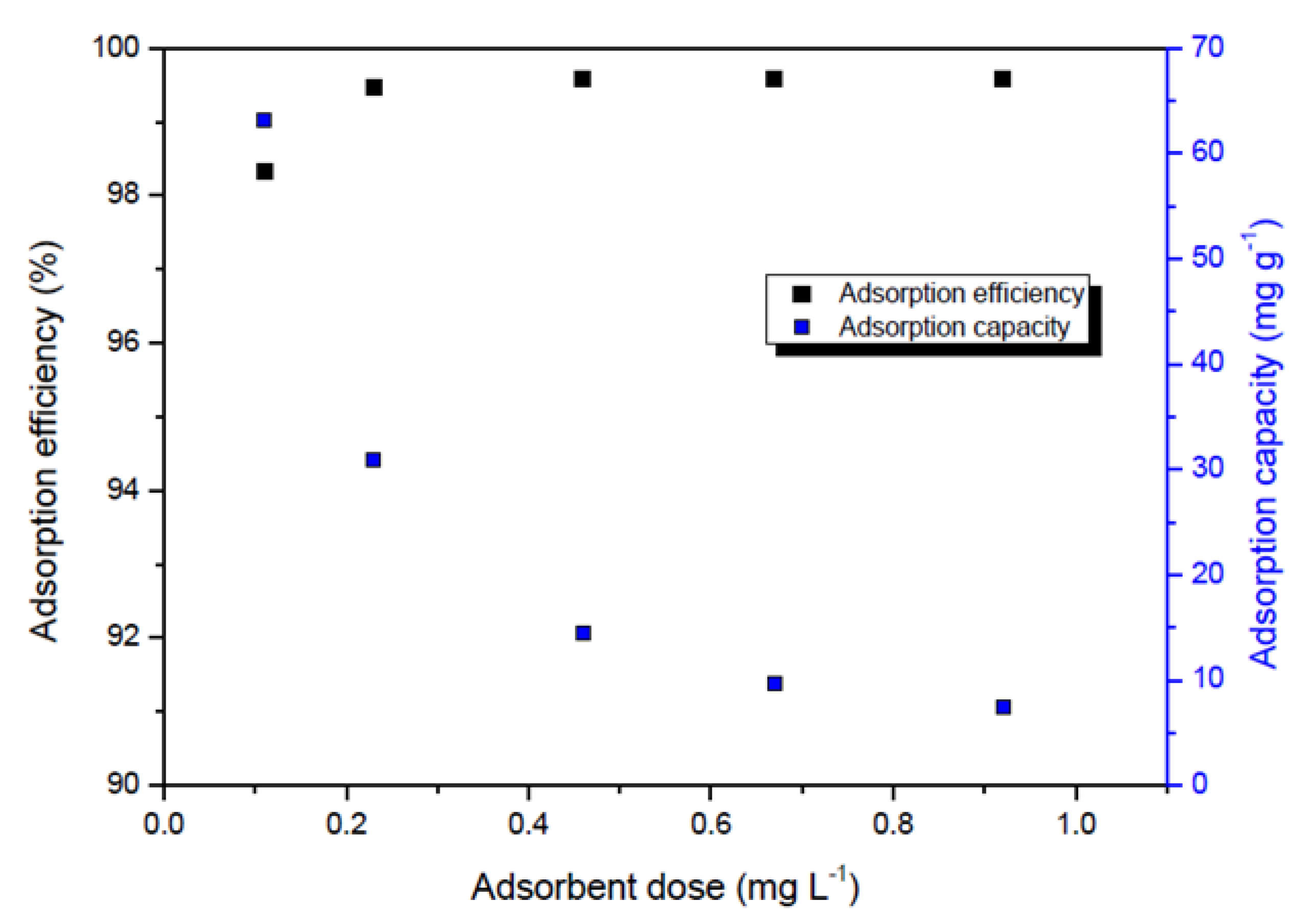

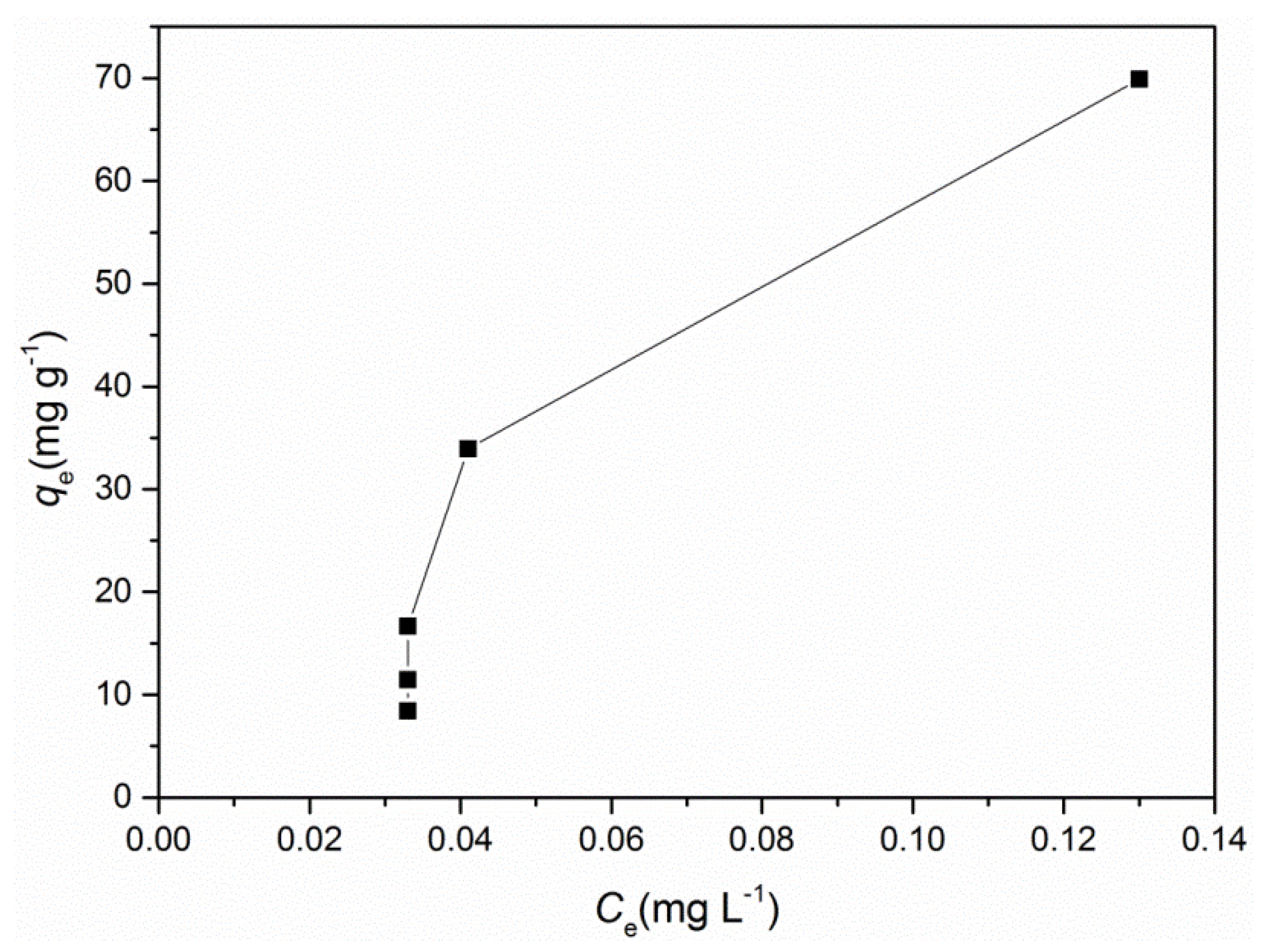
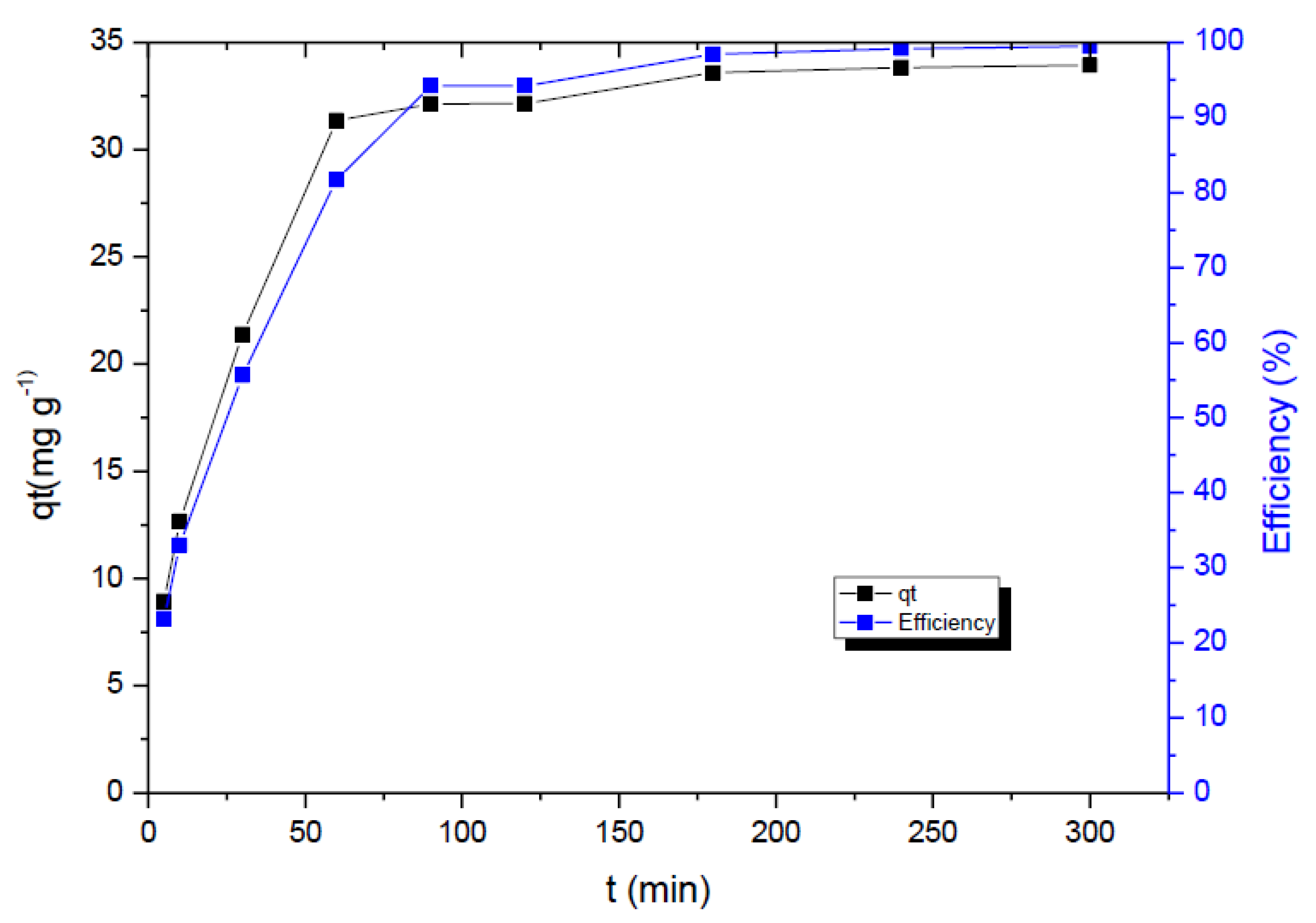

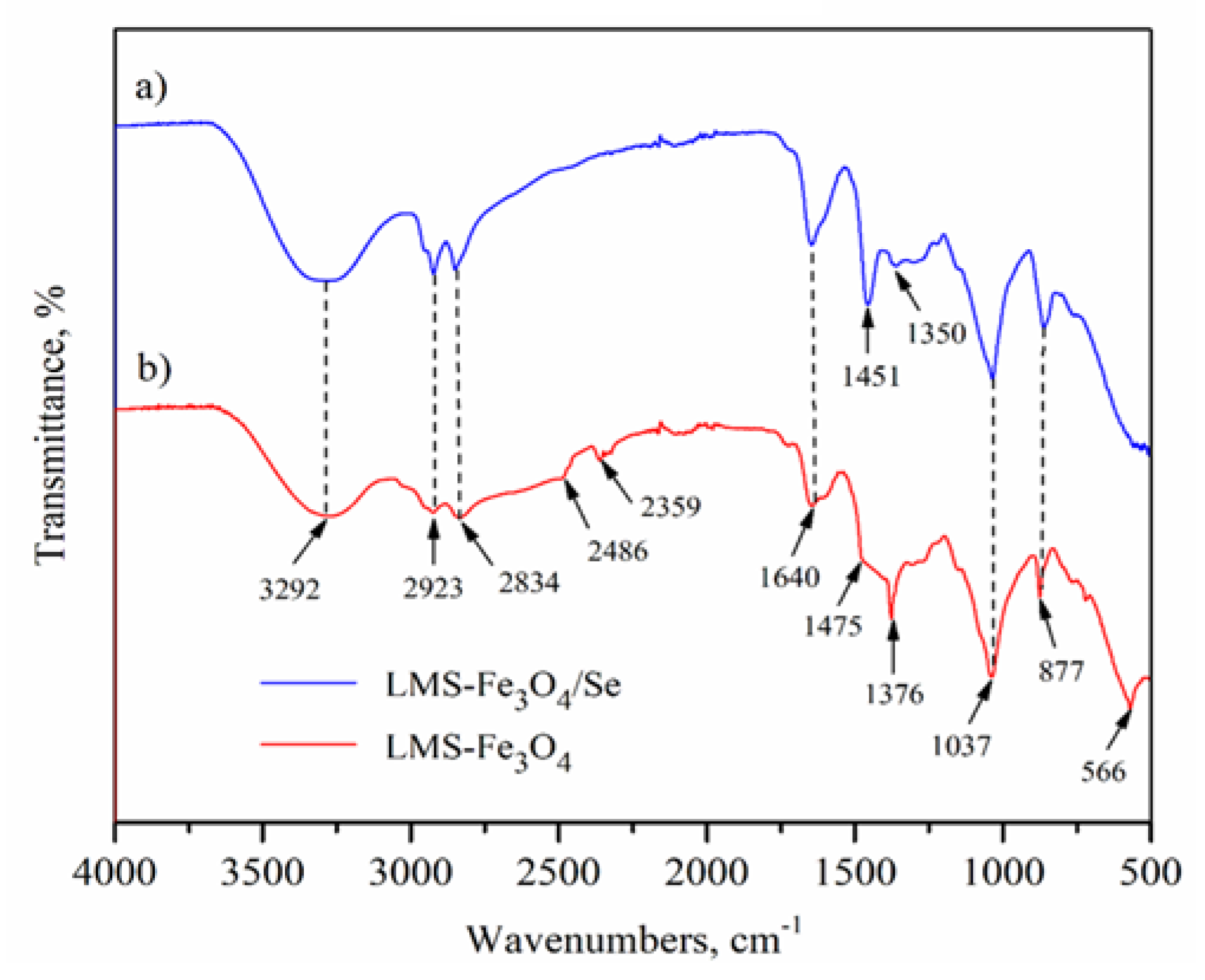
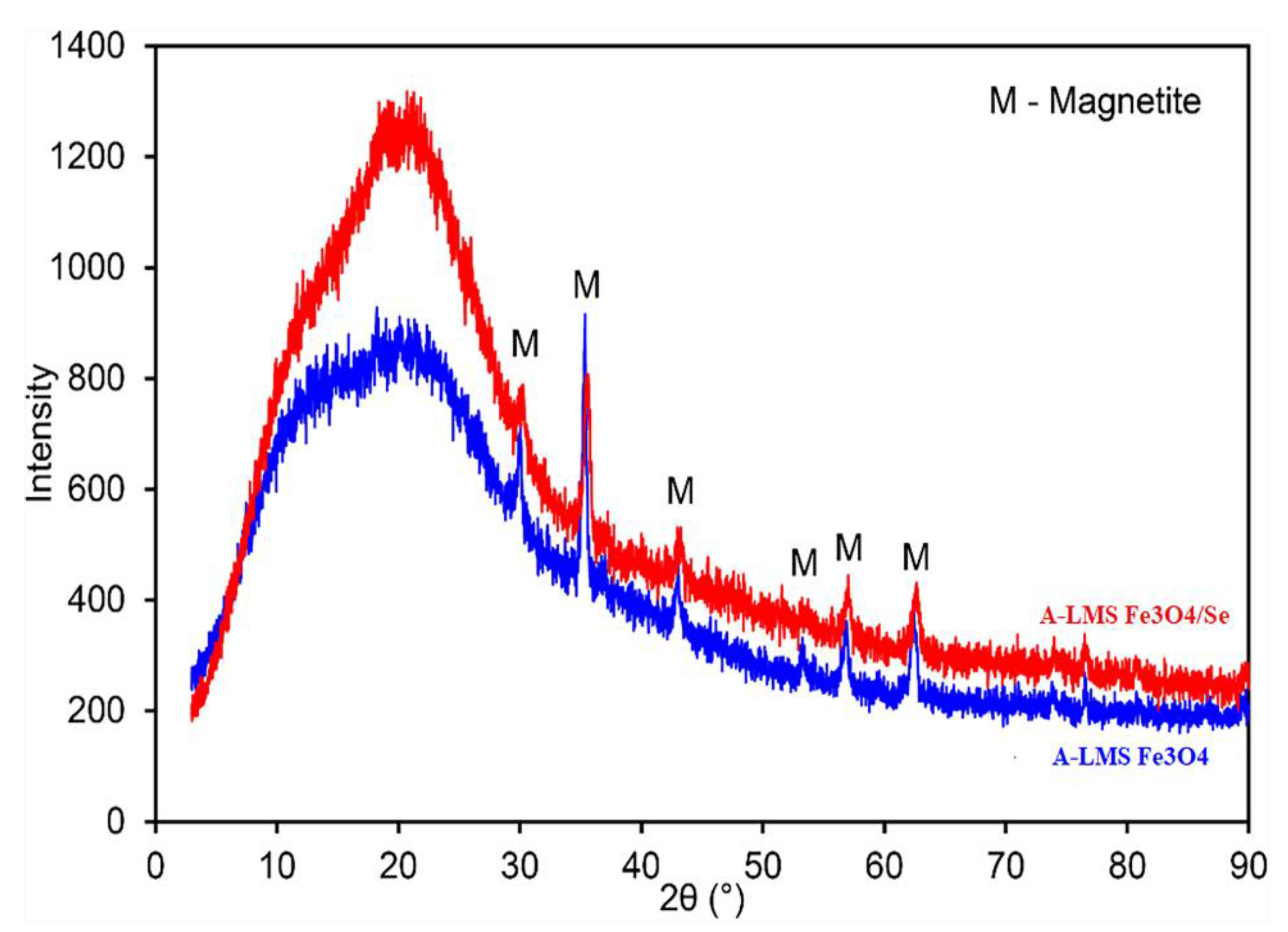
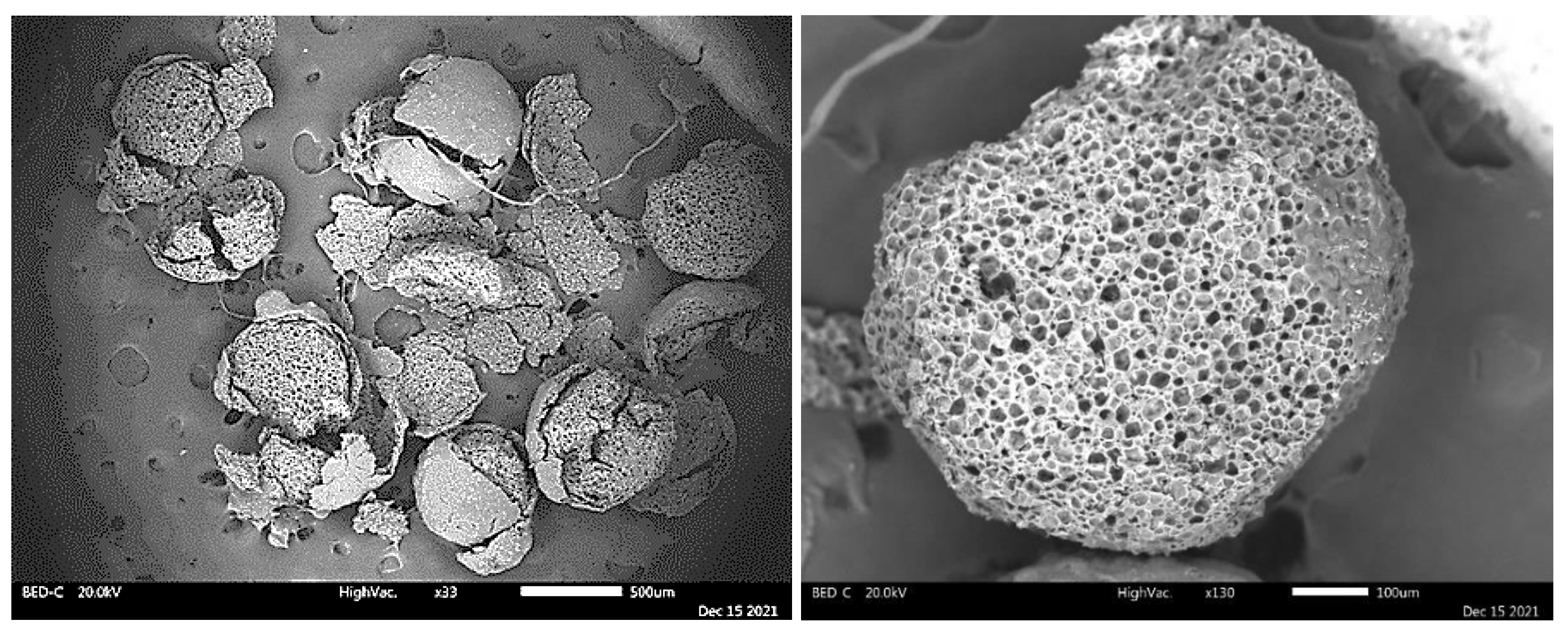

| Models | Pseudo-First Order Model (PFO) | Pseudo-Second Order Model (PSO) | Intraparticle Diffusion Model | ||||||
|---|---|---|---|---|---|---|---|---|---|
| Parameters | k1 (min−1) | qe (mg g−1) | R2 | k2 (g mg−1 min−1) | qe (mg g−1) | R2 | kid1 (mg g−1 min−1/2) | C1 (mg g−1) | R2 |
| 0.022 | 29.64 | 0.976 | 0.014 | 41.56 | 0.998 | 1.976 | 9.820 | 0.949 | |
| Spectrum Label | C, % | O, % | Cl, % | Fe, % | Se, % | Total, % | Figure |
|---|---|---|---|---|---|---|---|
| Spectrum 1 (1/x160) | 58.39 | 25.69 | 1.70 | 1.79 | 12.43 | 100.00 | Figure 8 |
| Spectrum 2 (1/x130) | 60.87 | 24.11 | 1.72 | 0.74 | 12.28 | 100.00 | Figure S1 |
| Spectrum 3 (1/x130) | 61.20 | 20.18 | 1.76 | 4.59 | 12.27 | 100.00 | Figure S2 |
| Spectrum 6 (1/x130) | 61.62 | 19.21 | 2.72 | 0.70 | 15.75 | 100.00 | Figure S3 |
| Spectrum 7 (1/x130) | 61.06 | 24.21 | 1.88 | 0.90 | 11.94 | 100.00 | Figure S3 |
| Sample | qe, mg g−1 | pHi |
|---|---|---|
| 1 | 14.08 | 7.67 |
| 2 | 8.80 | 7.32 |
| 3 | 7.48 | 7.48 |
| 4 | 6.16 | 7.42 |
| 5 | 4.94 | 7.21 |
| 6 | 4.84 | 7.00 |
Publisher’s Note: MDPI stays neutral with regard to jurisdictional claims in published maps and institutional affiliations. |
© 2022 by the authors. Licensee MDPI, Basel, Switzerland. This article is an open access article distributed under the terms and conditions of the Creative Commons Attribution (CC BY) license (https://creativecommons.org/licenses/by/4.0/).
Share and Cite
Marjanovic, V.; Markovic, R.; Steharnik, M.; Dimitrijevic, S.; Marinkovic, A.D.; Peric-Grujic, A.; Đolic, M. Lignin Microspheres Modified with Magnetite Nanoparticles as a Selenate Highly Porous Adsorbent. Int. J. Mol. Sci. 2022, 23, 13872. https://doi.org/10.3390/ijms232213872
Marjanovic V, Markovic R, Steharnik M, Dimitrijevic S, Marinkovic AD, Peric-Grujic A, Đolic M. Lignin Microspheres Modified with Magnetite Nanoparticles as a Selenate Highly Porous Adsorbent. International Journal of Molecular Sciences. 2022; 23(22):13872. https://doi.org/10.3390/ijms232213872
Chicago/Turabian StyleMarjanovic, Vesna, Radmila Markovic, Mirjana Steharnik, Silvana Dimitrijevic, Aleksandar D. Marinkovic, Aleksandra Peric-Grujic, and Maja Đolic. 2022. "Lignin Microspheres Modified with Magnetite Nanoparticles as a Selenate Highly Porous Adsorbent" International Journal of Molecular Sciences 23, no. 22: 13872. https://doi.org/10.3390/ijms232213872





